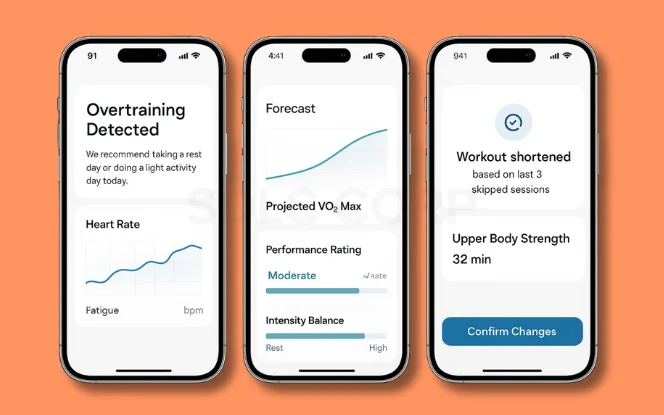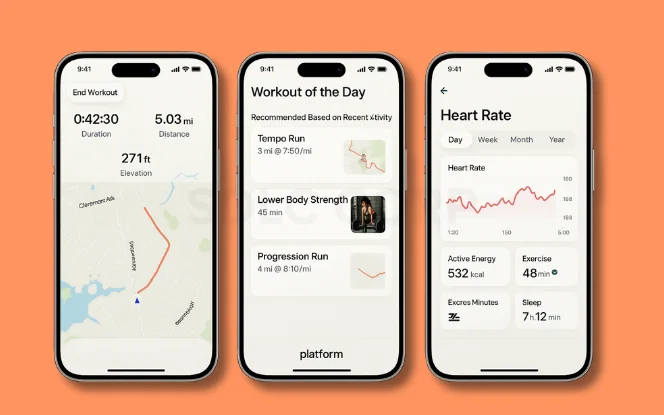Introduction
The global fitness app market is thriving, with Strava leading thanks to its powerful tracking, social, and community features. If you’re planning to build a fitness app like Strava, it’s essential to understand the development cost ranging from $20,000 to $100,000, depending on features, platform, and complexity. We’ve broken it into Basic, Mid, and Advanced tiers to suit different needs and budgets.
The financial potential is massive. The fitness app industry earned $6.8 billion in 2024 and is expected to surpass $30 billion by 2026, fueled by growing health consciousness, smartphones, and wearables. Now is the ideal time to invest in this booming market.
Why Build a Fitness App Like Strava?
Building a fitness app like Strava unlocks long-term business value through high engagement, daily user retention, and scalable monetization. As health-conscious behavior rises, the demand for smart fitness solutions grows. A well-optimized solution from an experienced Android App Development Company positions your brand at the center of this booming digital wellness ecosystem.

- Growing Market: The fitness app market is projected to exceed $30B by 2026, offering incredible growth potential for new apps.
- Health Awareness: Rising demand for lifestyle and activity tracking is driven by increased health consciousness across all age groups.
- High Engagement: Gamification, challenges, and performance tracking boost daily usage, ensuring strong retention and loyal user communities.
- Monetization Potential: Fitness apps profit from freemium models, paid features, and fitness gear partnerships making revenue streams highly scalable.
- Wearable Ecosystem: Integration with wearables like Apple Watch or Fitbit drives engagement through real-time health syncing and data accessibility.
Must-Have Features of a Fitness App Like Strava
1. Real-Time GPS Tracking for Outdoor Activities
Track distance, pace, and routes live using precise GPS and map integrations for outdoor workouts.
- View real-time location and speed
- Save and analyze past running/cycling routes
- Supports urban, trail, and off-road activities
2. AI-Powered Personalized Workout Plans

AI generates smart routines based on fitness level, goals, and previous performance data.
- Adaptive difficulty levels per user progress
- Integrates with goal-setting and reminders
- Offers video-guided workout suggestions
3. Social Sharing & Fitness Challenges

Create a fitness community with shareable workouts, group goals, and reward-driven competitions.
- Join monthly leaderboards and badges
- Share activities with followers or friends
- Comment, like, and compete on challenges
4. Heart Rate & Health Data Sync

Sync heart rate, calories, sleep, and other vitals from wearables and health tracking APIs.
- Compatible with Apple Health, Fitbit, Garmin
- Visualize metrics via graphs and logs
- Alerts for abnormal BPM and recovery stats
5. Progress & Performance Analytics

Advanced analytics provide real-time feedback on endurance, pace, and calories burned.
- Compare workouts across days/weeks
- Personalized progress dashboard with goals
- Export or share performance reports
6. AI-Powered Nutrition Guidance

Suggest daily meals, calorie intake, and hydration tips based on workout intensity and body metrics.
- Calorie calculator integrated with activities
- Recipe or diet suggestions per lifestyle
- Macro/micro breakdown tracking
7. Predictive Training with Machine Learning

ML adjusts your workout plan automatically based on skipped sessions or overtraining alerts.
- Forecast improvements or slowdowns
- Delivers tailored rest or intensity days
- Reacts to real-time performance dips
8. Virtual Reality Training Mode

Immerse users in guided workouts or simulated trails with real-time data overlay in VR.
- Integrates with VR treadmills/bikes
- Customizable virtual environments
- Real-time stats floating in VR HUD
9. Wearable Fitness Device Integration

Support seamless data sync with smartwatches and bands to track all fitness metrics.
- Auto-sync for heart rate, steps, and calories
- Works offline and syncs later
- Real-time alerts and vibrations
10. Customizable Dashboards & UI Themes

Give users full control over their visual dashboard, widgets, and appearance.
- Toggle metrics: steps, VO2 max, active time
- Light/Dark theme preferences
- Drag-and-drop widget layout
11. Voice Command Controls

Let users control app hands-free during workouts via voice assistants or onboard commands.
- Start, pause, stop via voice
- Playback coaching tips during exercise
- Voice feedback on progress
12. Augmented Reality Routes

Enhance outdoor runs with AR visual overlays and interactive navigation in real environments.
- Route guidance projected in real time
- See POIs or checkpoints ahead
- Works with camera and GPS fusion
13. Live Streaming of Events/Workouts

Stream solo sessions or live fitness events with real-time viewer interaction.
- Broadcast personal workouts live
- Host fitness challenges with real-time scores
- Watch and comment on peer sessions
Technology Stack

- Frontend
Use React Native or Flutter to build cross-platform mobile apps with fast performance and a native-like experience. - Backend
Choose Node.js, Django, or Laravel to power the backend with scalable APIs and secure server-side logic. - Database
Implement PostgreSQL or MongoDB to manage user profiles, workout history, performance stats, and other structured data efficiently. - GPS / Maps
Integrate Google Maps API or OpenStreetMap for accurate route tracking, navigation, and geolocation services in real time. - Wearables
Support fitness data syncing via Apple HealthKit and Google Fit APIs, ensuring seamless integration with smartwatches and fitness bands. - Cloud Hosting
Utilize AWS or Firebase for reliable cloud infrastructure, real-time syncing, and scalable backend deployment. - Analytics & AI
Leverage TensorFlow Lite or Firebase ML Kit to power machine learning features like predictive training and personalized workout recommendations.
Choosing the right tech stack is crucial for performance, scalability, and efficiency. Explore the latest tools driving innovation in 2025 in our blog on Must-Have Mobile App Development Tools.
Factors Influencing the Cost

- App Complexity
The inclusion of advanced features such as real-time tracking, analytics, or social sharing significantly increases overall fitness app development costs. - Platform
Building a Strava-like fitness app for both iOS and Android requires more resources, increasing development hours and total project cost. - AI/ML Features
Adding machine learning for predictive analytics and personalized fitness plans boosts the app’s value and development cost significantly. - Third-Party APIs
APIs for GPS, wearables, and health data add value to your app but also increase overall integration and testing costs. - UI/UX Design
Custom UI/UX design ensures a unique brand experience but adds considerably to the total fitness app development cost.
Cost to Develop a Fitness App Like Strava
| Tier | Basic MVP | Mid-Level (Includes Basic) | Advanced (Includes Basic + Mid-Level) |
|---|---|---|---|
| Cost | $20K – $30K | $40K – $50K | $60K – $100K |
| Timeline | 4–6 Weeks | 10-12 Weeks | 20–24 Weeks |
| Included Features |
|
|
|
| Security | HTTPS, JWT, Secure login | 2FA, Biometric authentication | End-to-end encryption, GDPR & HIPAA compliance |
| Integrations | Firebase, Google Maps API | HealthKit, Fit APIs, OneSignal | Stripe, AI APIs, AWS, ARKit |
| Tech Stack | Flutter, Firebase, Node.js | React Native, PostgreSQL, Express.js | Microservices, GraphQL, AWS Lambda, TensorFlow |
| Analytics | Workout logs & basic trends | User engagement & goal progression | AI forecasting, retention metrics, performance heatmaps |
Monetization Models for a Strava-Like Fitness App

- Freemium
Offer basic features such as activity tracking for free, while charging for advanced analytics and performance insights. - Subscription
Introduce monthly or annual plans that unlock premium capabilities like goal setting, historical trends, and in-depth health data. - In-App Ads
Display targeted ads from fitness brands, sportswear companies, or health partners for monetization without disrupting user experience. - Affiliate Sales
Earn commission by promoting fitness gear, smartwatches, or sponsored events through integrated affiliate partnerships. - Premium Features
Provide exclusive tools like custom route planning, heatmaps, and one-on-one coaching sessions under paid tiers.
Step-by-Step Process to Develop a Strava-Like App

1. Ideation & Research
Conduct competitive analysis, identify user needs, and define unique value propositions to validate your fitness app idea in the market.
2. Feature Planning
Map out essential features such as GPS tracking, activity analytics, and social interaction. Develop a detailed product roadmap and MVP scope.
3. UI/UX Design
Create wireframes and interactive prototypes with a clean, modern interface that focuses on seamless navigation and user engagement.
4. Frontend & Backend Development
Use technologies like React Native for the frontend and Node.js/Django for the backend to build a robust, scalable app architecture.
5. API & Wearable Integration
Integrate third-party APIs like Google Maps, Apple HealthKit, and Google Fit for real-time fitness tracking and wearable sync.
6. Testing & QA
Implement rigorous manual and automated testing processes to detect bugs, optimize performance, and ensure consistent cross-device user experiences.
7. Launch & Post-Support
Publish your app to the App Store and Google Play. Offer ongoing maintenance, performance monitoring, and feature updates to retain users.
Conclusion
The cost to develop a fitness app like Strava depends on several factors including feature complexity, platform selection, tech stack, and integration requirements. Whether you aim to build a basic fitness tracker or a feature-rich platform with AI, GPS, and wearable sync, understanding each cost component is essential for efficient budgeting and execution. As the demand for health-focused digital solutions continues to rise, now is the right time to invest in scalable, user-centric Mobile App Development Company for the fitness industry.
Have questions or need detailed guidance? Contact us to explore your fitness app development goals with confidence.
Related Blog to Explore

















